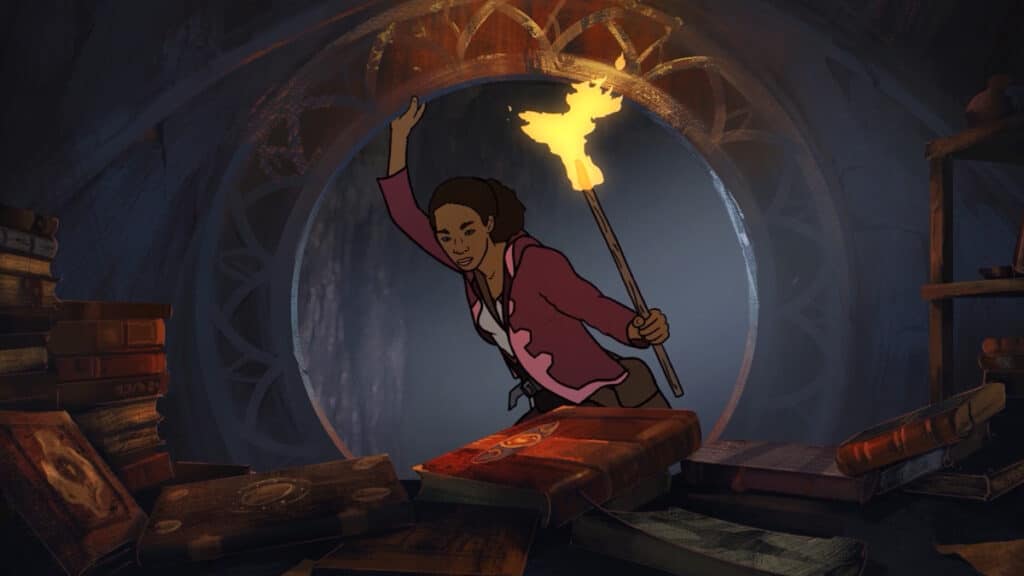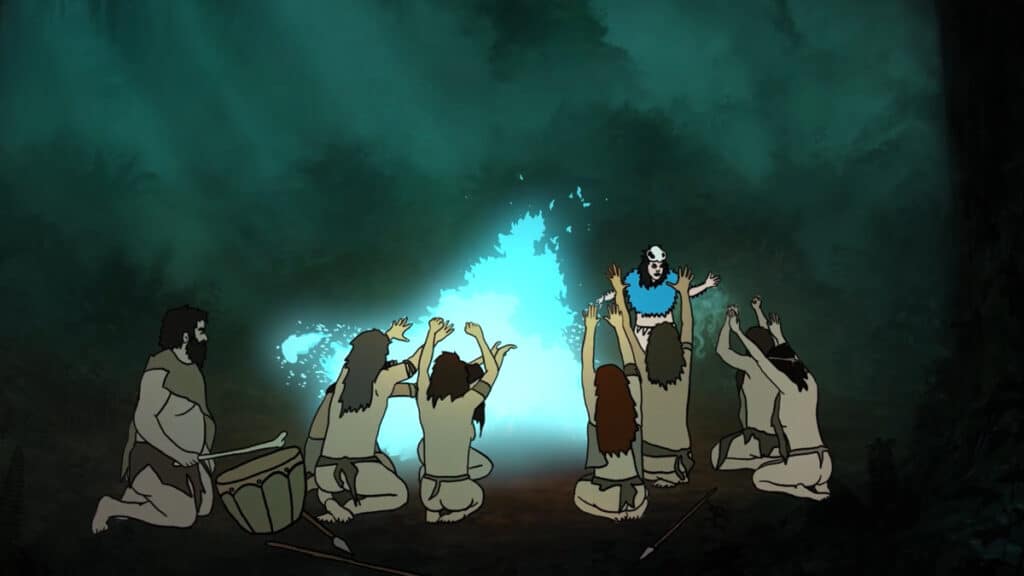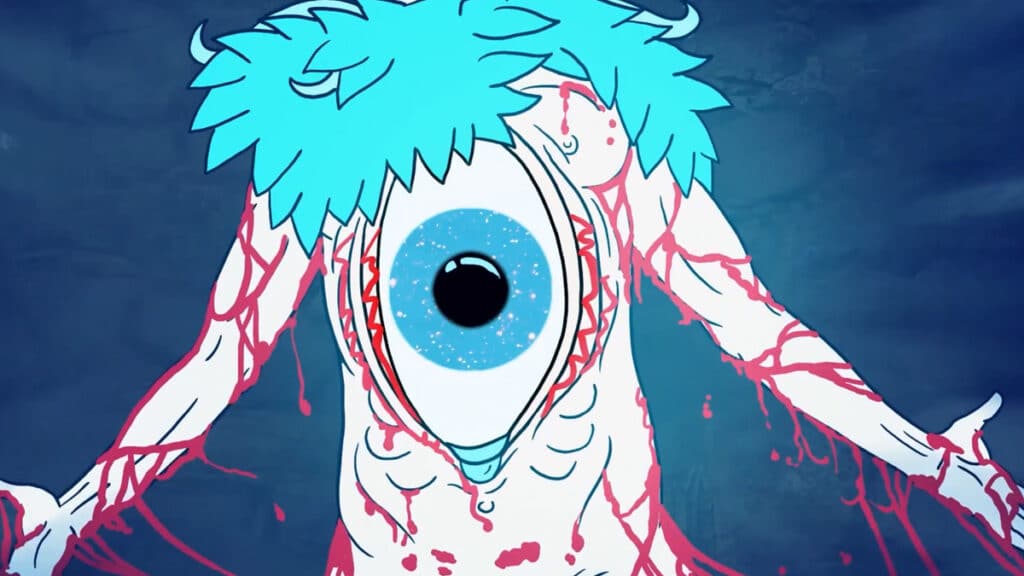SXSW 2021 Review: The Spine of Night
The Spine of Night (2021) is an animated, American fantasy film. It was written and directed by Philip Gelatt and Morgan Galen King.
The Spine of Night begins with a naked woman, Tzod (Lucy Lawless), trudging through frozen tundra, seeking a hoary sentinel in an Agamemnon looking mask, named The Guardian (Richard E. Grant). Once Tzod locates The Guardian, she begins telling him tales about the strange blue bloom that he protects. Tzod also possess some of this mysterious bloom herself.
As the two converse, the story of the blue bloom is told through a series of vignettes that trace its destiny, and use by humans over time. We see Tzod using it to defend her tribe. We see a bald guy use it to become some sort of demi-god. We see all kinds of crazy crap happen to a bunch of the various inhabitants of this world, as they seek to possess, or to run from the power contained within this strange blue plant.

I’ve got to be honest here. I had some difficulty following the plot of this film. Unfortunately, I got lost somewhere along the way, and fairly close to the beginning. There are just some films that I have a hard time following. I’m not quite sure why, but my own personal brand of stupidity always seems to emerge the victor when we try to engage with certain films. Spy films for example. I’m terrible with spy films. I get lost pretty quickly.
Take Tinker Tailor Soldier Spy (Tomas Alfredson, 2011) for example. After about ten minutes into the film, I was like “ya lost me.” I spent the remainder of its 127 minute runtime ogling Gary Oldman, and reflecting on what an amazing actor is is, and always has been, while being completely oblivious to whatever the actual story was. John Hurt was good too.
In full disclosure, I’m certain my cinematic comprehension was seriously impaired by the copious amount of alcohol I had consumed prior to the screening. But I promise you, it would have been the same without the booze. The only difference would have been that it would have taken me an extra five minutes or so to become completely lost. Also, while inebriated, I didn’t care that I was lost. Sober, the rest of my viewing experience would have been replete with endless self-recrimination about what an idiot I am and how stupid I felt.

So I can’t really offer up a better synopsis than I already have. While I’m certain there is an audience for this film; one that will absolutely devour the entire thing with relish and gusto, sadly I am not a member of that audience. This film is for the hardcore D&D marks. The kind of people who play Settlers of Catan at their local meadery, The kind of folks who attend any and all Renaissance Faires, Viking festivals, and Celtic games in requisite attire. If any of the last few records you listened to were by bands like DragonForce, Nightwish, or Korpiklaani, you will likely love this flick.
This is not a slam on anyone of this ilk, mind you. I firmly believe in throwing oneself headlong, and whole-heartedly into whatever it is that they are passionate about. I’m just saying that I don’t get as chuffed on those aforementioned things as other so, and that The Spine of Night is likely to hold a much greater appeal for those folks than it did for me. I also do not mean to suggest that there are not others who would like this film. I’m just saying that if I found out that the genesis of the film occurred during a weekly Hero Quest session between friends, I would not be surprised.
To circle back to an earlier point, The Spine of Night is not like Tinker Tailor Soldier Spy in any way other than that I found the story in Spine to be as abstruse as TTSS. If we want to talk about films that The Spine of Night IS similar to, the two most obvious would be Heavy Metal (Gerald Potterton, 1981), and Fire and Ice (Ralph Bakshi, 1983).

The and anthological style of Heavy Metal has been adopted for this film. The story of the blue bloom is told in a similar fashion to that of the Loc-Nar in Heavy Metal. Visually, the film has the rotoscoped look of much of Bakshi’s work. While I am uncertain how this film was produced, it looks rotoscoped as fuck. Certainly this is what the filmmakers intended. Unfortunately, the story that is being told is not as immediately comprehensible as that told in Heavy Metal, nor is it as engaging as that of Fire and Ice. Not that either of those films were great or transcendent either. However, given the choice, I would revisit either of those two films before I would revisit The Spine of Night.
Once again, it comes down to a style over substance kind of thing. It feels like the filmmakers were mostly concerned with crafting a film that fit a certain aesthetic, and that fit neatly within a specific genre. Creating a story with characters that were relatable, or that an audience could or would actually care about seems to have been an afterthought. However, if a series of gory, hyper-violent scenes of combat is what stokes the flames of your interest, then there may be something for you here.
On a stylistic level, the film is successful and very cool. The designs of the various characters and their world are creative. The film is very imaginative; the story of the bloom is complex and epic in scope. The battle scenes revel in their bloody freedom. The film wears its love of its predecessors like a badge of honor. I must have missed the “thank you” credits for Boris Vallejo and Frank Frazetta. On several levels, there is much to love here.

Additionally, I have often felt that Ralph Bakshi is a far more noteworthy and important filmmaker than he is EVER given credit for. Bakshi is a guy who did what he wanted to do and he did it in his way, the entire world be damned. Just like many of the greatest filmmakers of all times, Bakshi’s work never really connected with the kind of audience that makes the money men in Hollywood happy. Consequently, his has been a career fraught with adversity. Yet he has still managed to produce some of the most significant animated features in the history of the medium. If The Spine of Night has the corollary effect of turning people on to the work of Ralph Bakshi, I would consider it a success.
Unfortunately, I found The Spine of Night to be tedious. I was unable to fully follow the story, nor was I able to care when I checked out. Additionally, while some of the V/O work is very good, many of the other actors seem miscast. I did pause to ask myself if it was possible that I am so accustomed to British accents in films of this nature that the American accents in the film were throwing me off. Shakespeare’s poetry and prose almost always sounds believable when being delivered by an English person. In my experience it is much less so when delivered by Yanks. Would I have been satisfied with the voice acting in the film had they all been English? It’s hard to say. All I know is that I had a much harder time swallowing Patton Oswalt’s dialogue than I did Richard E. Grant’s.
The Spine of Night. Was it for me? I don’t think so. However, there is a sizable audience out there that will absolutely eat this shit up. Hopefully it can manage to find said audience. If the guys that made this can keep cranking out stuff like this that appeals to a niche audience that will continue to consume it, we’ve got a marriage made in Heaven. Sadly, I don’t think The Spine of Night will do much for people that aren’t really into this sort of thing.
Review
Rating
RN Review of The Spine of Night
I don't think The Spine of Night will do much for people that aren't really into this sort of thing.



